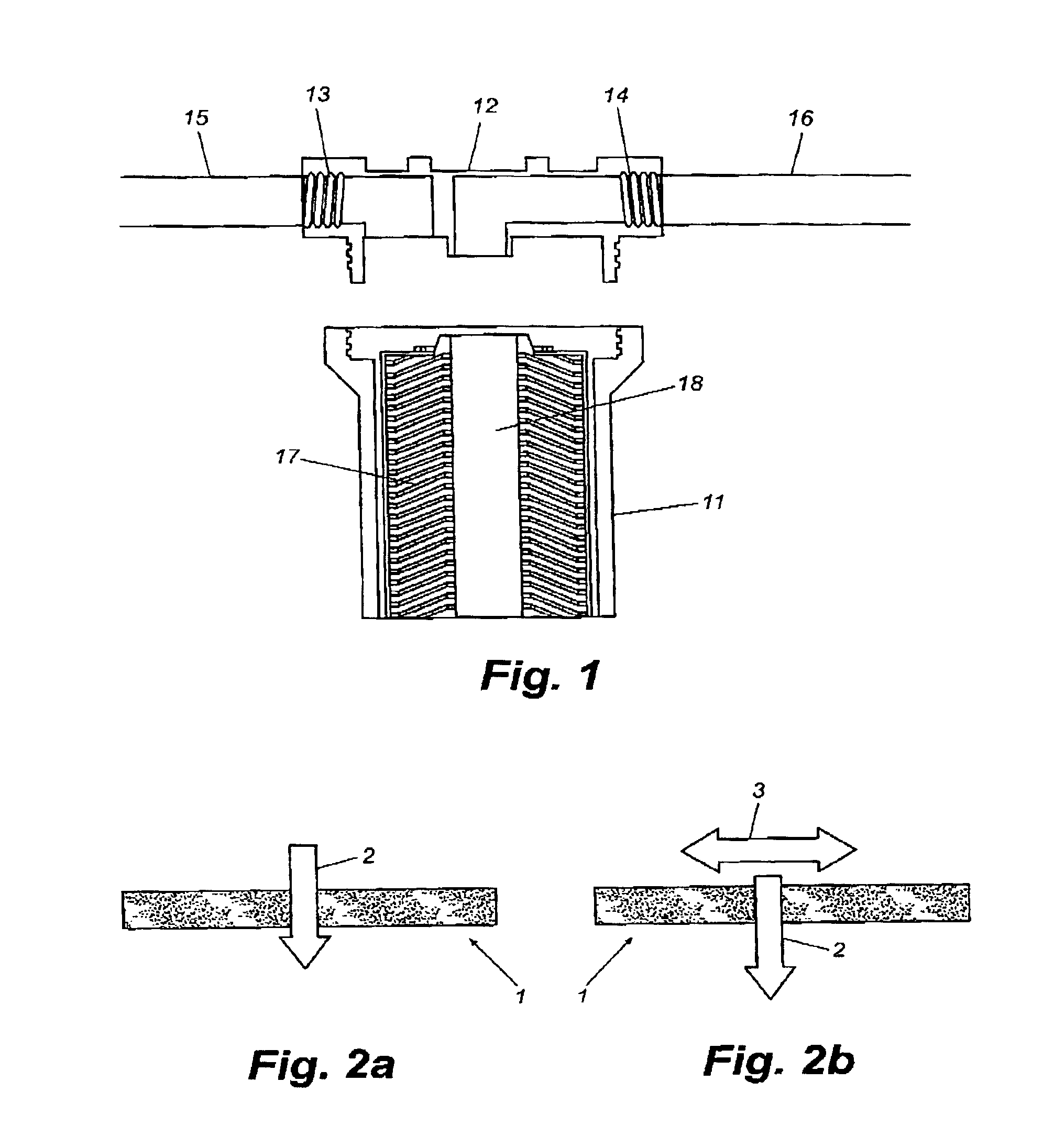Microbiological water filter
a microorganism and water filter technology, applied in the direction of liquid degasification, separation process, other chemical processes, etc., can solve the problems of affecting affecting the effect of channeling, and loose materials in loose forms, etc., to achieve the effect of compromising the effectiveness of filtering generated with loose materials
- Summary
- Abstract
- Description
- Claims
- Application Information
AI Technical Summary
Benefits of technology
Problems solved by technology
Method used
Image
Examples
example 1
[0054]As example of a fully functional device, a cylindrical filter block 17 of the shape shown in FIG. 1 was prepared with a material composition of approximately 42.5% BRIMAC 216 bone char obtained from Tate and Lyle, approximately 42.5% GAC obtained from KX Industries, and approximately 15% thermoplastic binder material selected from one or more of the thermoplastics described above.
[0055]The material was then extruded at a temperature that provided a uniform mixture of apatite, GAC, and thermoplastic binder.
[0056]The cylindrical or toroidally shaped block 17 was approximately 9.8 inches in length, with an outer diameter of approximately 2.5 inches and an inner diameter (the bore 18) of approximately 1.25 inches. This shape filter fits into a standard water filtration housing used in the home and industrial settings. The filter material had a resistance of about 300 Ω.
example 2
[0057]The filter prepared in Example 1 was challenged by exposing it to tap water that was filtered with activated carbon and then seeded with 2.3×108 colony forming units per liter of E. coli bacteria and 1.0×107 plaque forming units per liter of poliovirus type 1. The seeded water was passed through the filter block 17 at a flow rate of approximately 2 liters / minute for 3 minutes, followed by collection of a 500 ml effluent sample. The results of microbiological measurements on this 500 ml sample are presented in Table 1. E. coli was assayed on m-Endo agar plates by membrane filtration procedure, while the poliovirus type 1 was assayed by the plaque forming method on BGM cells. The results shown in Table 1 exceed the minimum EPA requirements for removal of bacteria and viruses
[0058]
TABLE 1logUnitOrganismInfluentEffluent% reductionreductionSingleE. coli2.3 × 108>99.9999957.36UnitTwo UnitsE. coli2.3 × 108>99.9999957.36SinglePolio1.0 × 107 3.3 × 10299.9964.49Unittype 1Two UnitsPolio1...
example 3
[0059]A second test was performed using the same seeded water as used in Example 2, and using two blocks prepared according to Example 1 in series. The results of effluent testing are also provided in Table 1. A comparison of performance between a single unit and a double unit with the units arranged in series demonstrates that one unit is sufficient to reach the detection limits of the assay and provide results that exceed the requirements of the EPA.
PUM
| Property | Measurement | Unit |
|---|---|---|
| pore size distribution | aaaaa | aaaaa |
| resistance | aaaaa | aaaaa |
| resistance | aaaaa | aaaaa |
Abstract
Description
Claims
Application Information
 Login to View More
Login to View More - R&D
- Intellectual Property
- Life Sciences
- Materials
- Tech Scout
- Unparalleled Data Quality
- Higher Quality Content
- 60% Fewer Hallucinations
Browse by: Latest US Patents, China's latest patents, Technical Efficacy Thesaurus, Application Domain, Technology Topic, Popular Technical Reports.
© 2025 PatSnap. All rights reserved.Legal|Privacy policy|Modern Slavery Act Transparency Statement|Sitemap|About US| Contact US: help@patsnap.com


